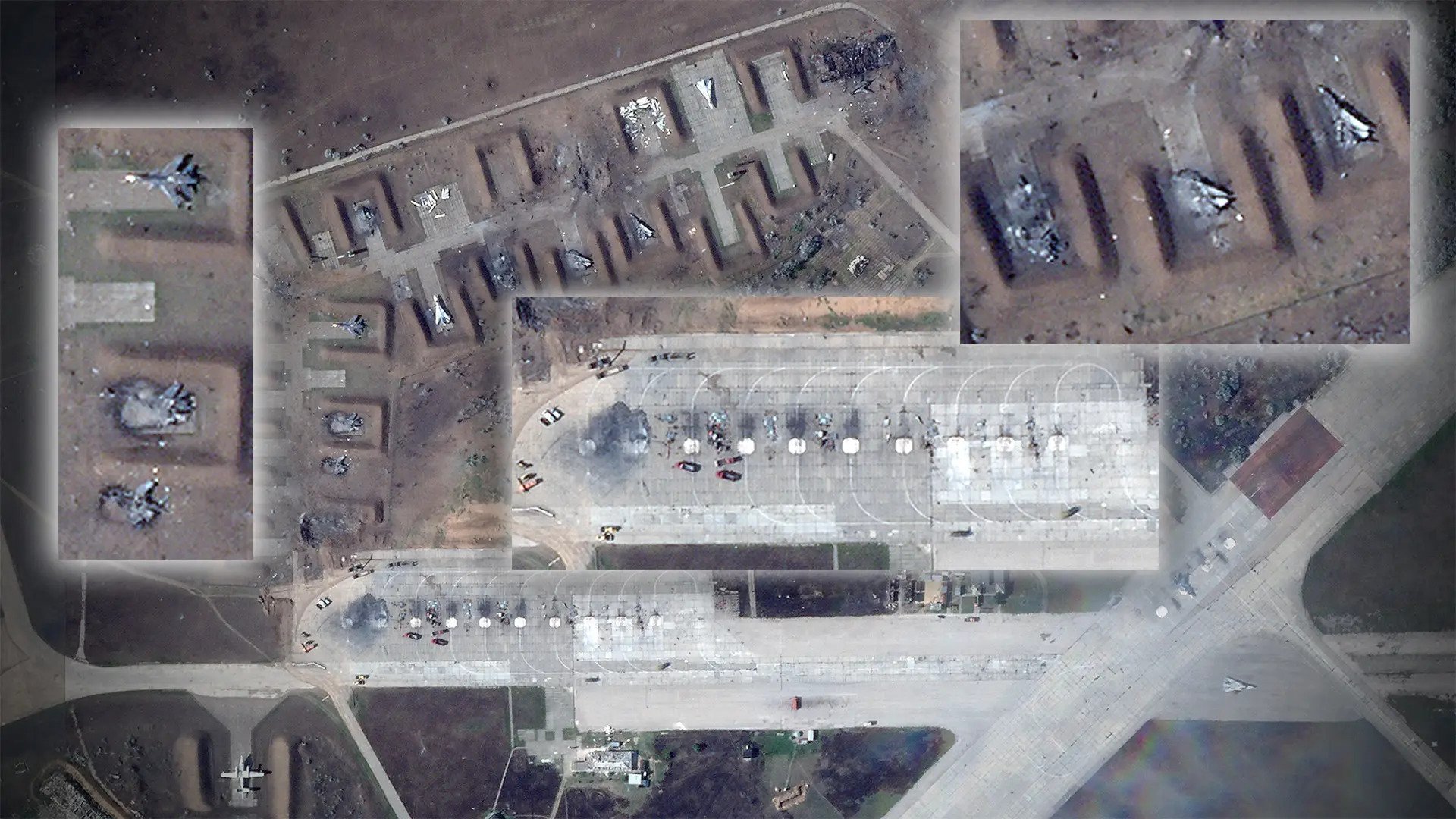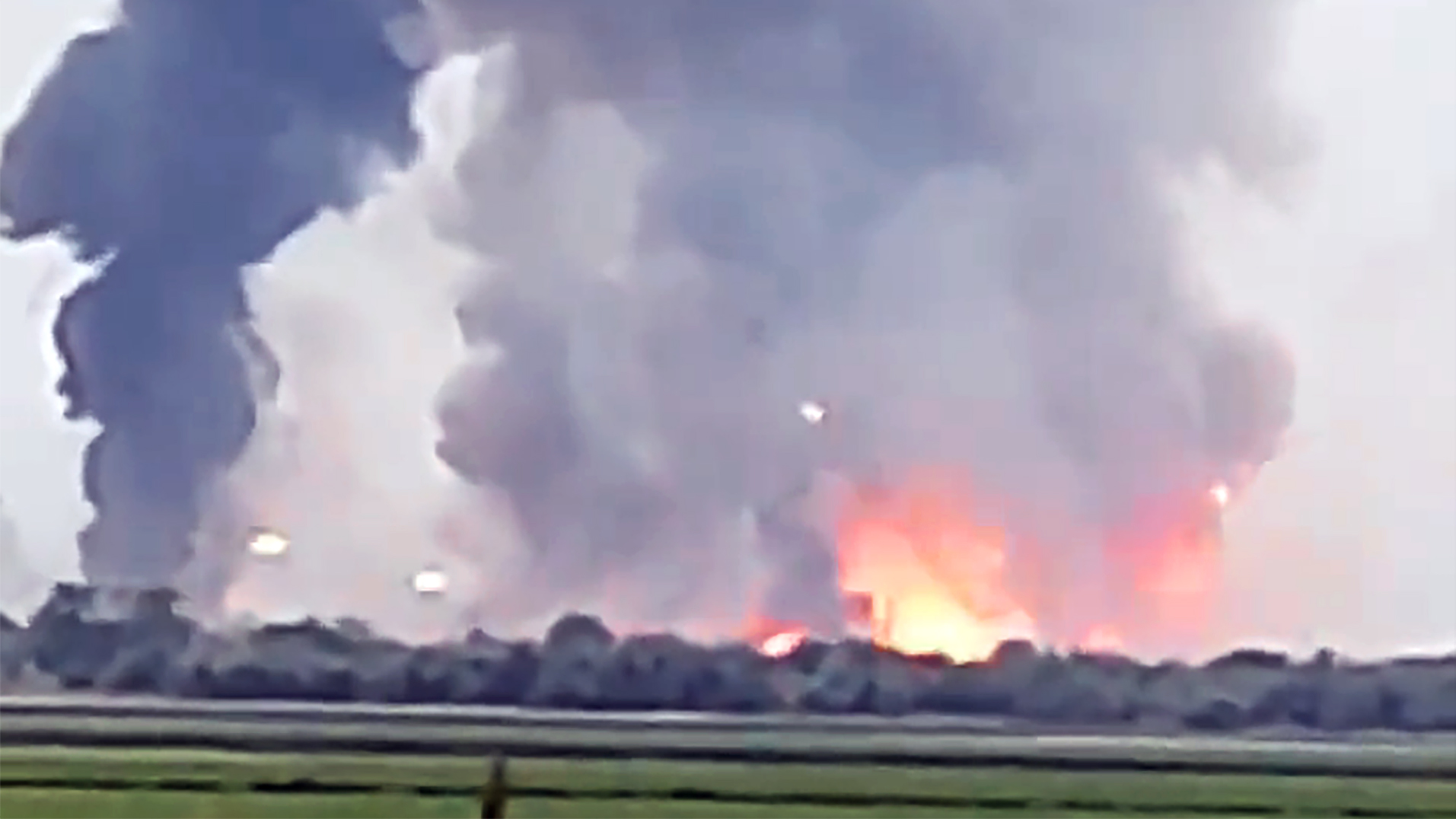In the latest string of apparent attacks on Russian military installations in Crimea, a Russian air base and an ammunition dump have been hit as Moscow claims at least one incident was sabotage while Ukraine claims it was the work of one of its elite military units.
Shortly after 6 a.m. local time, explosions rocked an ammunition dump at a military unit in the Dzhankoi region in the north of Crimea, apparently damaging key railroad tracks and an electrical substation, Russian media outlets reported. The area is about 30 miles from occupied Kherson and is an important railhead for Russian supplies.
As a result of the Dzhankoi incident, which comes a week after a number of military aircraft were damaged or destroyed by another series of mysterious explosions at the Saki Air Base, officials in Crimea declared a state of emergency Tuesday.
“We are in a state of emergency,” Crimean occupation governor Sergey Aksenov said on his Telegram channel.
“I am in the village of Azovsky, Dzhankoi district, where this morning, according to the Defense Ministry, a fire broke out on the territory of the temporary storage site of one of the military units’ ammunition. At the moment the detonation continues,” Aksenov wrote.
A five-kilometer zone has been cordoned off around the site of the incident and about 2,000 people were evacuated. “We are providing assistance on the spot. Ambulances, law enforcement agencies are mobilized in sufficient numbers,” he added.
That response was issued after several villages were affected in the Dzhankoi region, the Russian news agency RIA Novosty reported. And it comes after Ukrainian officials warned of sabotage attacks by partisans who want Crimea returned to Ukraine.
Images circulating on Twitter appeared to show roads in the area littered with munitions from that ammo dump.
The incident took place shortly after 6 a.m. local time at a fenced ammunition storage area of a military unit stationed in the village of Maiskoe. According to Aksenov, two civilians were slightly injured.
“During the scattering of ammunition, railway tracks were damaged, due to which seven passenger trains were delayed. The canvas has already been restored, but traffic will resume only after all security measures have been taken,” RIA Novosty reported.
An electrical substation was also apparently damaged.
Meanwhile, Russian media reported that a military air field at Hvardeyskye, about 35 miles southwest of Dzhankoi, was also on fire. Christo Grozev, lead investigator for Bellingcat, said in a Tuesday morning Tweet that the base “housed 12 SU-24М and 12 SU-25СМ planes and was integrated with the Russian Navy.”
The Russian Kommersant newspaper reported on its Telegram channel that “clouds of black smoke” were seen over the base and that Russian military and law enforcement officials are investigating whether a small drone attacked Hvardeyskye, home to the 37th Composite Aviation Regiment.
As for the explosions near Dzhankoi, the Russian Ministry of Defense blamed them on sabotage while the New York Times reported that the incident was the work of “an elite Ukrainian military unit.”
Ukraine officials have not taken responsibility yet for either attack. Last week, Ukrainian President Volodymyr Zelensky complained about leaks of information eminating from his military. However, one of his advisors on Tuesday hinted on Twitter of Ukrainian involvement at least in Dzhankoi.
In another coy message, the Ukrainian Air Force hinted that the explosions in Dzhankoi took place near a military base there housing the Russian 39th Helicopter Regiment.
The aftermath of Dzhankoi explosion was apparently captured in videos emerging Tuesday on social media that showed flames and plumes of smoke rising from that site.
The latest incidents in Crimea come exactly a week after the Saki Air Base – which Russia occupied when it took over the peninsula in 2014 – was rocked by still unexplained explosions.
The base is home to the Russian Navy’s 43rd Independent Naval Attack Aviation Regiment (43 OMShAP). This regiment flies a mix primarily of Su-30SMs and Su-24M/MRs, and made headlines during several encounters with NATO forces in the Black Sea in 2021.
Satellite imagery The War Zone obtained from Planet Labs of Saki Air Base showed that aircraft look to have been the hardest hit and specifically targeted, with at least 10 jets seen seriously damaged or destroyed. There is also visible damage to a number of aircraft revetments and other structures, but some key infrastructure appears to be unscathed. Uncertainty continues to surround the exact circumstance behind what happened at the base, as you can read about in detail in The War Zone‘s prior reporting here.

The strikes in Crimea seem to be well beyond the range of Ukraine’s long-range fires.
Ukraine has 16 M142 High Mobility Artillery Rocket Systems, or HIMARS, provided by the U.S. as well as three M270 systems provided by the United Kingdom.
Both can fire a variety of 227mm rockets, including Guided Multiple Launch Rocket System (GMLRS) types made by Lockheed Martin, as well as the Army Tactical Missile System (ATACMS) short-range ballistic missiles. So far, the U.S. has only provided Ukraine with an unpublicized amount of M31 rockets with 200-pound class unitary warheads, which are GPS/INS guided and can hit targets at a distance of around 43 miles (70 kilometers.) The Biden administration is reluctant to provide longer-range and harder-hitting ATACMS out of concern that it might expand the war beyond Ukraine’s territory. In particular, it could provide a means for Ukraine to execute precision strikes on a large variety of targets well into Russia via U.S. weaponry, which Russia could respond to by striking targets outside of Ukraine.
The administration has flat-out denied it has supplied ATACMS as recently as late last week.
Reacting to speculation about the Saki Air Base attack, the Pentagon last week said it could not be ATACMS because it had not provided Ukraine such munitions.
As with the Dzhankoi attack, a senior Ukrainian military official with knowledge of the situation told The New York Times that Ukrainian forces were behind the Saki explosion.
As a result, speculation has run rampant about what has been used in these attacks, running from smaller, locally operated, armed drones, to special operations sabotage raids like the ones carried about by the Shaman Battalion – which we profiled here – to the possibility that Ukraine has secretly fielded its own ballistic missile system. Ukrainian forces, or those loyal to Ukraine, have used small drones in a high-profile attack in Crimea against the Black Sea Fleet headquarters before all this started, at the time we said this was just a harbinger of things to come. Ukraine also possesses an off-the-shelf long-range precision drone attack capability that could be the culprit here. We just don’t know.
Though it is unclear exactly who is causing these attacks or how they are being carried out, one thing seem clear.
Russian military facilities on Crimea are likely to remain targets.
This is a developing story. Stay with The War Zone for updates.
Contact the author: howard@thewarzone.com
